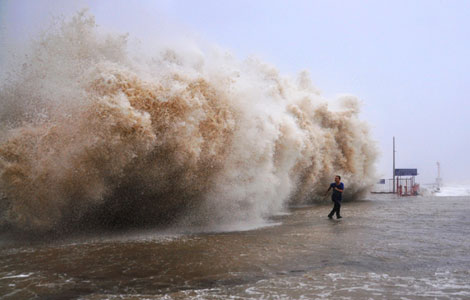Grapes of craft in Ningxia
Updated: 2013-09-23 07:15
By Sun Ye (China Daily)
|
||||||||
With help, harsh climate yielding high-quality grapes, Sun Ye reports.
Scant rainfall, soil strewn with rocks, cold hard winters and limited yields - that's the weather is like at the base of Helan Mountains near Yinchuan in Ningxia Hui autonomous region.
"It looks like the least promising conditions to grow any plant," said Cao Kailong, the head of the region's bureau for the grape and flower industries.
But it turns out the stretch of land at the foot of the mountains is ideal for wine grapes if modeled in the right way.
That is one of the things the International Organization of Vine and Wine , also known as OIV, will discuss as it gathers in Yinchuan.
Wang Wenyu, chief of Ningxia's forestry administration,told China Daily that OIV believes in the prospects of the winemaking area on the east of Helan Mountains and that's why it decided to cooperate with the Ningxia government to co-host the meeting.
"The symposium will showcase the region's enormous growth potential, increase its influence and fame, promotes exchanges between Ningxia and overseas wine industries, and advance the healthy and sustainable development of local wine industry," Wang said.
To further enhance cooperation with the international community in improving production safety and quality awareness and reducing the effect of adversity on winemaking, the upcoming meeting will have discussions focusing on the theme of "the optimized viticulture and winemaking under stressed conditions", he added.
"Making high-quality wines is always the key to our success, and we will continue the efforts to be a world-class wine production center in the future," he said.
"By 2020, the grape planting area in Ningxia is expected to reach 6.67 million hectares, and we also plan to build one grape culture center, three ecological zones and 10 counties with unique grape culture."
"By learning from those top experts, I hope we could make big stride in boosting Ningxia's wine industry in the near future."

And making good wine depends on good grapes. In this case, "forced growth" will bring out the best grapes.
"To a certain extent, it's the dreadful climate that shapes the best qualities. It's like you brave the cold and become stronger still," Cao said.
The cold hard winters, so severe that the grapes need to be covered with a layer of soil, also deters insects. When grape growing has to be organic, prohibiting chemical pesticides, cold is a blessing in disguise.
Not having enough water works in the same way. The region receives 200 millimeters rainfall each year, just half the average of 400 mm that grapes need. But the aridness also drives away insects and harmful microorganism.
"Moreover, we can control and moderate the humidity to our liking," Wang Zhenping, professor and director of Engineering Research Center of Wine and Grape with Ningxia University, said.
"Grapes don't even want fertile soil where nutrition comes too easy," Wang said. He has been researching grape growing for more than 10 years and is on the advisory board for the region's wine-making blueprint.
"The vines need to go deep into the ground for nutrition - the deeper, the better in minerals they get and taste of the grapes," Wang said.
But that also means limited yields.
"We don't want mass-produce grapes anyway," Cao said. "The climate is good for a relatively small output of quality grapes and we want just that."
Wang said growers even will prune away crowded bunches of grapes to get each one sunlight and air.
"For wine grapes, it's not about the number, but each one has to be of equal high quality."
That quality will promise a rare balance and harmony in taste. That's why chateaus instead of mass-producing factories are often preferred.
"They're more responsible and will weigh the quality more than the quantity," Cao said. "As long as you produce high quality you are sure to make money."
Many growers have already invested in the area including Moet Hennessy, the wine and spirits unit owned by French luxury group LVMH. It will establish the first winery in China dedicated to premium sparkling wine. The first bottle is scheduled to be uncorked in 2014.
Grape cultivation now covers 34,000 hectares across the region. Seventy-seven winemaking businesses have been established with a combined production capability of 179,000 tons. Another 4,000 hectares of vineyards will be allotted in the city before the end of this year, according to the Ningxia Forestry Bureau.
It's projected to become a 200 billion yuan ($32 billion) industry for the city in the coming 10 years, local officials said.
Besides wine production, wine-themed tourism and other related businesses will join in to make a fully developed business chain.
There will be a display to showcase wine culture, 10 wine-themed resort towns and 100 chateaus established, according to development plan by the autonomous region government in 2011.
There is reasoning behind the ambitious figure - China is rapidly gaining momentum to become the world's seventh largest wine consumer.
In the country's second-and third-tier cities, which include the northwestern city of Yinchua, total revenues of Chinese wines reached $129 million, according to a report by the China Alcoholic Drinks Association.
"We have found our niche in high-quality wine," Cao said.
"The most important thing is to be careful and patient."
Contact the writer at sunye@chinadaily.com.cn
|
Grapes for making wine grow at the foot of Helan Mountains. Photos Provided to China Daily |
|
A local farmer dries grapes. |
|
Barrels of wine are stored at a cellar in Yinchuan. |
|
Foreign experts conduct research in a vineyard near Helan Mountains. |
|
A participant in a wine tasting shares his opinions on wine made in Ningxia. |
(China Daily USA 09/23/2013 page8)
Most Viewed
Editor's Picks

|

|

|

|

|

|
Today's Top News
Israeli soldier killed in West Bank shooting
Death toll in Nairobi mall attack rises to 68
Verdict for Bo Xilai: Life in prison
Amber alert across Asia, but not red
China foreign minister at UN
Smithfield shareholder vote Tuesday
China signs 12 deals with Venezuela
Trending news across China
US Weekly

|

|


















